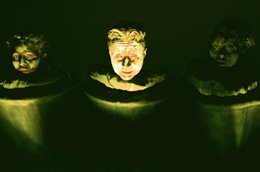Mouth on Fire was established last year with the intention of staging the shorter plays of Samuel Beckett. Directed by Cathal Quinn, 'Silence and Darkness’ is a programme of four pieces rarely performed in Ireland.
In Rockaby (1980) an old woman (Nolan) swings back and forth on a rocking chair, her body rhythmically emerging into light and receding into darkness. Her pre-recorded voice carries the narrative, which is comprised of events recalled from her own life, as well as that of her mother’s. The play is structured into four sections, and Nolan speaks live only to punctuate her disembodied voice with the demand "More." This interruption stands out from the deliberate monotony of the rest of the piece. While Nolan is careful and somewhat affecting in her delivery, her face is too theatrical in its whiteness. Further, the sidelight intended to illuminate her rocking spills onto the stage and front rows, drawing attention away from the main focus. In the small Focus space, the technician's Mac and lamp at the back of the theatre similarly casts light on more than it should.
Catastrophe (1982) follows, in which a director and his assistant put the finishing touches to a scene by painstakingly manipulating a performer’s body. While Quinn, playing Director, sits in the front row to implicate us in the play’s subject, the production foregrounds the scenario as a dramatisation of torture. Dedicated by Beckett to the Czech playwright and dissident Václav Havel who was imprisoned under Soviet occupation, the faceless performer who stands on a small box and moves to order could be replicating an image from Abu Ghraib. The dialogue is largely played as casual banter, to the extent that it’s easy to lose impact. This is particularly true of Laverty’s overly brusque performance as Assistant.
Revisiting Rockaby’s preoccupations with aging and memory, A Piece of Monologue (1979) presents us with an old man who tells the story of an individual understood to be himself. Standing alone in his night clothes, and flanked by a lamp, in his earnest tale he calculates the length of his life in the third person, remembers dead loved ones, and leads us to a graveside where he relates the scene in filmic terms: "Umbrellas round a grave. Seen from above. Streaming black canopies […] Thirty seconds…Then fade." Like Rockaby and  Catastrophe, this play is also concerned with the machinery of representation, where the act of living and making theatre are intertwined. Lamb captures the figure’s speech and poise well, although he has a tendency to be too physically dramatic on stage, directly engaging the audience with his address.
Catastrophe, this play is also concerned with the machinery of representation, where the act of living and making theatre are intertwined. Lamb captures the figure’s speech and poise well, although he has a tendency to be too physically dramatic on stage, directly engaging the audience with his address.
The programme ends on a lighter note with Play (1963), which while no means a pure comedy, draws humour from the polyphonic confessions of three figures recounting an affair. Performers Laverty, Quinn and Nolan are buried up to their heads in urns, and their emetic sequences are provoked by a spotlight controlled by a figure at the front of the stage, who employs athletic hand gestures to signal cues. While the piece raises laughs, the play's form is more musical than dramatic, and here poor pacing detracts from the overall effect. Playing the woman on stage left, Nolan’s affected diction renders her words especially tough to comprehend.
It’s the technical precision that Beckett’s shorts demand that usually pose problems for performance. While this young group should be commended for their ambitious project which allows us to see rarely produced work, the performances struggle to maintain the formal rigour required to stage the shorts effectively. There’s room for manoeuvre with many other playwrights and genres, but Beckett’s corpus isn’t quite so forgiving.
Fintan Walsh